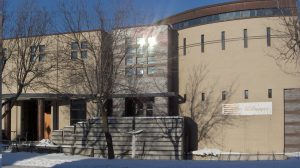After nearly half a century, the national archives of the Canadian Jewish community is leaving the Samuel Bronfman Building in downtown Montreal, to a new location in the Côte-des-Neiges neighbourhood.
The Alex Dworkin Canadian Jewish Archives (ADCJA), formerly the Canadian Jewish Congress (CJC) National Archives, will open to the public at its new location at 4810 Jean Talon St. W., suite 211, after Labour Day – by appointment only for the time being.
The archives had been located in the CJC’s former national headquarters on Docteur Penfield Avenue at Côte-des-Neiges Road since the building opened in 1970. (The archive itself, which documents much of the history of Canadian Jewry, dates back to 1934.)
The Jewish community turned the building over to Concordia University in 1999, when the CJC moved its national office to Ottawa. The agreement was that the archives could remain in the basement for 15 years, rent-free. In March 2017, the university gave the ADCJA a year’s notice to leave, said Janice Rosen, who has been the director of the archives for 30 years.
Packing the over 1,500 linear metres (the equivalent of 4,500 banker’s boxes) of archives, some of which are in fragile condition, has been a painstaking process that has had been taking place over many weeks.
Finding a new home was even more challenging and several sites were considered, said Rosen. It had to meet exacting physical requirements, be affordable and accessible to users, she said. Proximity to the heart of the Jewish community would have been ideal, but nothing panned out.
READ: THE STORY OF CANADA’S POSTWAR JEWISH ORPHANS
The floor had to be strong enough to support up to 45 kg per square foot and climate control was essential.
The oldest document in the archives dates back to 1765, but most of the documents are from the late 1800s onward. They range from papers from Jewish organizations – many of which, including the CJC, are now defunct – to the memorabilia that belonged to ordinary families.
Virtually anything relevant is given consideration, said Rosen, but some materials, such as those relating to the arts or Jewish education, are referred to the Jewish Public Library (JPL) archives, or the various regional archives across the country.
ADCJA and the JPL jointly manage the online Canadian Jewish Heritage Network, where most of the descriptions of their holdings can be consulted.
The ADCJA has been administered by Jewish Federations of Canada-UIA since the CJC was dissolved in 2015. Besides Rosen, assistant director Hélène Vallée is the only other full-time staff member.
ADCJA will occupy rented space in the commercial building, right above the Splendid Chocolates. The size is about the same – slightly over 5,000 sq. ft – but all of it can be used, and more efficiently, said Rosen, because it is an open rectangle, rather than the previous triangular space.

Another advantage is the natural light that comes through the windows – something that was not present in the basement. Parking is also easier, there is public transit nearby and the building is wheelchair accessible.
The relocation committee includes architects Gerald Soiferman and Jake Fichten, as well as real estate adviser Harvey Elman.
The moving and increased operating costs are being supported by the Azrieli Foundation, the Jewish Community Foundation of Montreal’s Dworkin Fund, Federation CJA, the Labour Zionist Alliance, the Bibliothèque et Archives Nationales du Québec and JFC-UIA.
The ADCJA receives 1,000 inquiries a year from scholars, researchers, filmmakers, writers and ordinary people. Up to 250 of them work on-site.
“The ADCJA has been acknowledged for its help in virtually every Canadian Jewish history and sociology book published since 1980 and appears in the credits of numerous film and television productions,” said Rosen.
Queries range from historical facts to descriptions of everyday Jewish life at various points in history.
The ADCJA has been acknowledged for its help in virtually every Canadian Jewish history and sociology book published since 1980.
– Janice Rosen
A corps of dedicated volunteers is relied upon, and some have toiled in the archives for decades.
Archives chair Norma Joseph, a Concordia religion professor and CJN columnist, said that, “In some ways, it is challenging, as all moves represent some element of loss. Yet, it is also a moment in which we can celebrate a fresh start, with a transition to growth and expanded space.
“Significantly, as we planned this move, we were greeted with enhanced communal participation and support; clearly, an auspicious beginning.”
Several works of art, reminders of the Jewish community’s presence in the Samuel Bronfman Building, have been left behind. They include two large pieces that have been hanging since the early 1970s: Joyce Rose’s Jerusalem, which was donated by Ray and Rose Wolfe, and Twelve Tribes of Israel by Norman Laliberté.
The Walter Redinger sculpture consisting of four totemic pillars will also remain outside the enterance.
Rosen said the art is on loan to Concordia until such time as the building’s vocation changes. Avant-garde in its time, the building was designed by Fred Lebensold, the architect of the National Arts Centre. It continues to house the university’s Azrieli Institute of Israel Studies and Institute for Canadian Jewish Studies.






